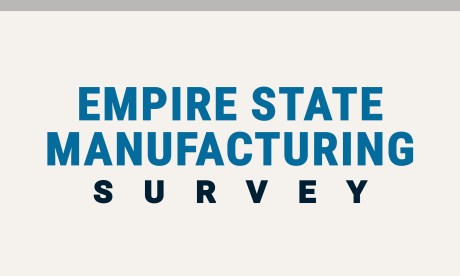
The rapid rise in Artificial Intelligence (AI) has the potential to dramatically change the labor market, and indeed possibly even the nature of work itself. However, how firms are adjusting their workforces to accommodate this emerging technology is not yet clear. Our August regional business surveys asked manufacturing and service firms special topical questions about their use of AI, and how it is changing their workforces. Most firms that report expected AI use in the next six months plan to retrain their workforces, with far fewer reporting adjustments to planned headcounts.
Among businesses using AI over the past six months, 10 percent of service firms had reduced worker counts in response to AI and 5 percent had increased them, while no manufacturers had made such changes. Among those planning to use AI over the next six months, firms expect to hire more workers than fire workers to accommodate its use, and about half plan to retrain current staff to use it. These results are consistent with economic arguments than downplay alarmism about AI’s potential to displace workers and instead point to its potential to augment employment and fill labor shortages.
Current and Future Use of AI among Regional Businesses
Our August surveys asked businesses in the New York-Northern New Jersey region whether they used AI to help produce goods or services in the past six months. This included the use of virtual agents or chatbots, machine learning, text or data analytics, generative AI, speech/voice recognition, and robotics process automation. As indicated in the table below, 25 percent of service firms reported using AI, as did 16 percent of manufacturers. The most widely cited use was for marketing or advertising, as well as for business analytics and customer service. Among AI users, about 80 percent were using generative AI services. About half of service firms using AI and nearly three-quarters of manufacturers using AI were engaging a free service such as ChatGPT.
Service Firms Anticipate Modest Growth in AI Use while Manufacturing Firms Do Not
| Service Firms | Manufacturers | |||
|---|---|---|---|---|
| Yes | No | Yes | No | |
| Have used AI in the past six months | 25% | 75% | 16% | 84% |
| Plan to use AI in the next six months | 32% | 68% | 16% | 84% |
Businesses were also asked about their expected AI use in the next six months. About a third of service firms plan to use AI—7 percentage points higher than the share reporting use in the previous six months. By contrast, the same share of manufacturers (16 percent) reported having used AI as planning to use AI in the future. Across the two surveys, about three-quarters of those using AI in the past six months planned use of AI in the next six months, suggesting some persistence in its use.
Businesses Plan to Retrain Workers to Adapt to AI
Respondents were next asked whether they had hired, laid off, or trained/retrained workers due to the use of AI in the past six months, and about their future plans for AI-related staffing in the next six months. Five percent of service firm AI-users had hired new workers to accommodate the technology, while 10 percent reported laying off workers—most of whom had at most a high school diploma or GED (see chart below). By contrast, manufacturers reported no change in worker counts to accommodate AI.
Businesses Expect Growth in Share of Workers Retraining for AI Use
Service Firms
Share of AI users (in percent)
Manufacturers
Share of AI users (in percent)
Source: Federal Reserve Bank of New York, Regional Business Surveys, August 2024.
While little change in worker counts was reported among AI users, many firms had trained their workers to use it, including about a quarter of service firm AI users and 31 percent of manufacturing AI users. The large majority of workers being retrained for AI use had either some college, technical training, an associate’s degree, or a bachelor’s degree or higher.
Among firms that plan to use AI in the future, 19 percent of service firms and 7 percent of manufacturers expected to hire new workers in the next six months due to its use, a rise of 14 percentage points and 7 percentage points, respectively, compared to reported use in the past six months. By contrast, only 12 percent of future service firm AI users and none of the future manufacturing AI users plan to lay off workers in the next six months due to AI. These dynamics suggest firms plan net hiring due to the use of AI, not net worker reductions. Interestingly, planned new hires would mostly require only a high school diploma, pointing to the potential for AI to induce hiring of less educated workers.
Plans to train workers to adapt to AI use in the next six months dwarf expected net hiring dynamics. A striking 53 percent of service firms and 47 percent of manufacturers that plan to use AI in the future expect to retrain workers in the next six months, much higher than the shares reported over the past six months of 24 percent and 31 percent, respectively. This expected retraining is concentrated among workers with higher education.
Wage Expectations
We also asked regional firms about wage expectations for current employees across the education spectrum due to the use of AI. Most respondents reported negligible expected changes in the next six months across education levels, ranging from a 1.5 percent decline to a 1.4 percent increase. In over three-quarters of responses, businesses expected no change in wages in the next six months due to the use of AI. Among those expecting changes, a larger share of respondents expected an increase in wages than a decrease in wages.
The table below reports the share of firms expecting wage increases minus the share expecting decreases across educational categories. In every case, the share expecting wage increases exceeds the share expecting declines. Interestingly, the share of service firms reporting positive wage growth expectations relative to declines is higher for more educated workers. Among manufacturing firms, wage growth is expected to be most widespread at both the low and high ends of the educational distribution.
Service Firms Expect the Largest AI-Related Wage Increases for the Most Educated Workers, while Manufacturers Expect the Largest Increases for Both Low- and More Highly Educated Workers
| Education | Share expecting wage increase minus share expecting wage decrease | |
|---|---|---|
| Service Firms | Manufacturers | |
| High school degree or GED | 2% | 9% |
| Some college, technical training, or associate’s degree | 6% | 4% |
| Bachelor’s degree or higher | 14% | 8% |
How Will AI Shape the Labor Market in the Future?
Overall, the survey results do not point to significant reductions in labor due to AI use in the past six months nor expected reductions over the next six months. Indeed, so far, it appears that firms are finding ways to utilize existing workers through training/retraining and are planning to hire new workers to work with AI. These findings are consistent with a recent Dallas Fed survey on AI use as well as new academic research examining online vacancies that suggests labor market effects of AI may be “currently too small to be detectable.” Some of what firms expect may also stem from overoptimism since AI is so new or be shaped by the tight labor market conditions of recent years in which hiring has been difficult. More changes might also come later when AI is more fully integrated into business processes. As such, we will continue to monitor the use of AI by firms in the region and provide updates as additional data and information become available to improve our understanding of how AI will shape the labor market in the years to come.
Production note: Please observe a shift in how we share results of special topical questions added to our regional business surveys. Formerly, the responses were published about four times per year in a Supplemental Survey Report, following the release of the Empire State Manufacturing Survey and the Business Leaders Survey. From today, the responses to the special questions will be synthesized periodically in analysis on Liberty Street Economics. Keep track of the subjects we cover at Regional Business Surveys: Special Topics.

Jaison R. Abel is the head of Urban and Regional Studies in the Federal Reserve Bank of New York’s Research and Statistics Group.

Richard Deitz is an economic research advisor in Urban and Regional Studies in the Federal Reserve Bank of New York’s Research and Statistics Group.

Natalia Emanuel is a research economist in Equitable Growth Studies in the Federal Reserve Bank of New York’s Research and Statistics Group.

Ben Hyman is a research economist in Urban and Regional Studies in the Federal Reserve Bank of New York’s Research and Statistics Group.
How to cite this post:
Jaison R. Abel, Richard Deitz, Natalia Emanuel, and Benjamin Hyman, “AI and the Labor Market: Will Firms Hire, Fire, or Retrain?,” Federal Reserve Bank of New York Liberty Street Economics, September 4, 2024, https://libertystreeteconomics.newyorkfed.org/2024/09/ai-and-the-labor-market-will-firms-hire-fire-or-retrain/
BibTeX: View |
Disclaimer
The views expressed in this post are those of the author(s) and do not necessarily reflect the position of the Federal Reserve Bank of New York or the Federal Reserve System. Any errors or omissions are the responsibility of the author(s).













 RSS Feed
RSS Feed Follow Liberty Street Economics
Follow Liberty Street Economics